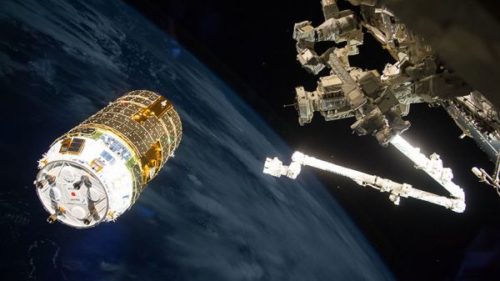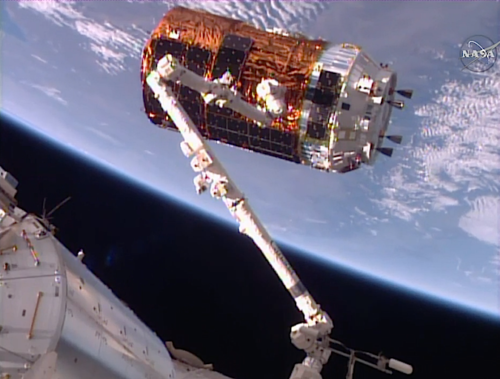Four days after the successful launch of the H-2B rocket from the Tanegashima Space Center (Japan), as planned, the TuPOD safely arrived at the International Space Station (ISS), on-board the HTV-6 supply ship. In fact, the HTV-6 docking went along on schedule: on Tuesday December 13, at 10:39 a.m. (GMT), “KOUNOTORI6” was captured by the ISS’ robotic arm (Canadarm-2, 17.6 meters-long) and berthed to the ISS on December 13, at 6:24 p.m. (GMT).
The spaceship has been installed on the Earth-facing port of the Harmony Module of the ISS with the guidance of ground controllers and docked to the Station by its crew that started unloading the cargo. This way, the TuPOD was delivered to the ISS astronauts, together with the payloads prepared by the Japanese Aerospace Exploration Agency (JAXA).
The mission’s cargo consists of more than 4.5 tons of delivery, including space equipment such as ISS battery Orbital Replacement Units (ORUs), hardware, food, water and space clothing for the astronauts living in the ISS, research experiments plus 7 CubeSats including the satellite/deployer GAUSS TuPOD (and its two nanosatellites aboard).
The HTV-6 transfer vehicle is an unmanned cargo type of spacecraft used to deliver supplies to the International Space Station. It is composed by the following main components: two logistic carriers, the Pressurized Logistics Carrier (PLC) and the Unpressurized Logistics Carrier (ULC) which includes the Exposed Pallet (EP) and an Avionics and a Propulsion Modules.
This mission is the sixth successful flight of this resupply vehicle, since 2009 and represents a technological advance.
After having been attached to the ISS, in order to serve its purpose of delivering the supplies to the on-board crew, the spaceship will remain berthed for six weeks (in this time period the astronauts will perform spacewalks to replace some of the ISS batteries with the new ones that the HTV-6 is carrying). The astronauts will then place waste materials aboard the vehicle and undock it to re-enter the atmosphere; eventually, after having performed some experiments, the craft will destroy itself in the upper atmosphere.
Later on (around January 2017, more info will be available soon) the TuPOD will be deployed into Space, in turn releasing its on-board TubeSats, TANCREDO I and OSNSAT, three and a half days later.
Here you may find some external references about the TuPOD Project:
- TechWave News on the TuPOD project
- Dentsu Space Lab interview on TuPOD project
- Spaceflight Now press news about HTV6 Mission
- EoPortal page on HTV6 Mission

HTV-6-approaching the ISS’ robotic arm – Courtesy of NASA

HTV-6 resupply vehicle being caught by the ISS’ robotic arm on Dec 13 – © NASA TV/Spaceflight Now
Video of the catching (render) in Japanese
